--A pilgrim to Xi'an, Luoyang
Jane Chen / Shanghai Daily news
Bidding farewell to Xi'an, I took the train to Luoyang, another famous
ancient capital city in China. Situated in the west of Henan Province, it was
the starting point of "the Silk Road".
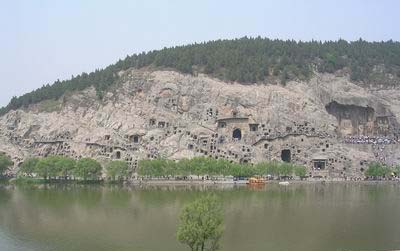
My first stop was the Longmen Grottoes. The site, whose construction
began 1,500 years ago and took some 400 years to complete, was listed by UNESCO
as a World Cultural Heritage Site in 2000. The grottos, together with the
Mogao Caves in Dunhuang (Gansu Province) and the Yungang Grottoes (Shanxi
Province), are considered the three greatest stone sculpture treasure houses in
China.
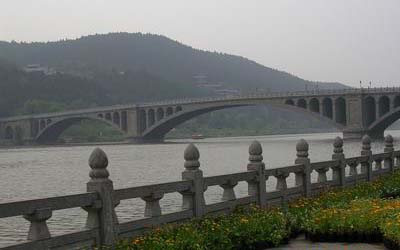
I passed a gate under the Longmen Bridge, which spans the Yi River. The river
runs between two hillsides where numerous caves, each with stone Buddha
carvings, line the hills for over 1,000 meters. While some caves are as
small as a book, others are as enormous as thee-storey buildings. Stone figures
of Buddha fill each of the grottoes.
In one famous cave are 10,000 carved Buddhas, with the biggest one some 10
meters tall and the smallest the size of the palm of your hand. When I stared
into the dark cave from the fence, I mistook the small Buddhas arranged at the
back of the cave for written lines.
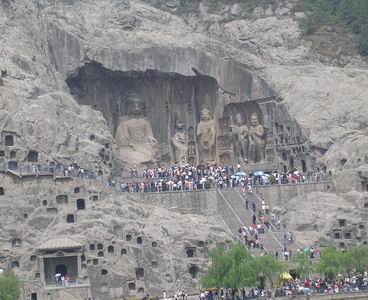
Many of the Buddhas have no heads, some because of the long years of erosion,
and others because of robberies. In the complete stone Buddhas, I found
smiling faces, flowing cassock lines and shapely figures. These full
images reflect the beauty standards of that time.
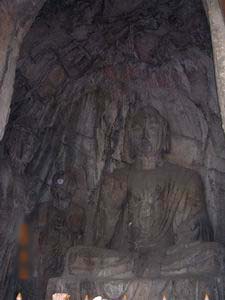
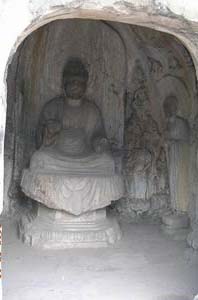
I would have had more interest in the sculptures if I had had a better
knowledge of Buddhism. With no basic religious ideas, I became bored with the
stone carvings after two hours of wandering through the grottos. In each cave, I
could see nothing but stone Buddhas and lotuses. Alas!
Buddhists must be able to read more from the carvings. My guide said
different Buddhas are worshipped in the caves with illustrations of related
religious stories. The grottos were used by different royal family members of
the Tang Dynasty as a private worship place.
Sightseeing cars are available to carry tourists back from the exit of the
site to the entrance, because the exit is on the opposite side of the river from
the entrance. But I opted to walk the 1-kilometer distance. The 15
minutes' walk under the willows along the riversides and over the Longmen Bridge
is refreshing.
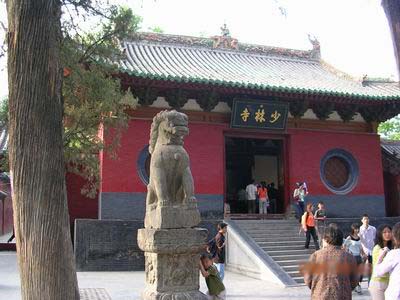
Another world-renowned site near, though not in, Luoyang, is the Shaolin
Temple, a royal temple of the Tang Dynasty. Its acclaimed martial arts
enticed me into taking a 3-hour bus ride from Luoyang.
Entrance to the temple is at the foot of Songshan Mountain, where the temple
is actually located. This long distance of nearly two kilometers is
for environmental protection around the temple site. The temple is
applying for UNESCO's World Cultural Heritage Site status. Some thousands
of martial arts schools had been opened in the area. The local authority
has earmarked 200 million yuan to clean them out. On the shuttle bus from
the entrance to temple, I did not see any martial arts schools but only clean
natural landscape.
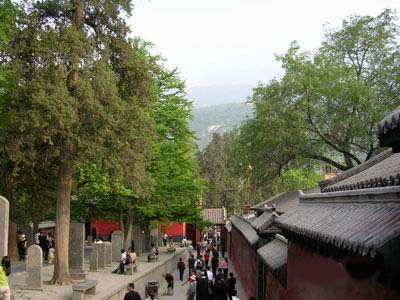
Beyond my expectations, the temple is small. The three golden Chinese
characters of "Shao Lin Si" on the stele are said to be scripts of Kangxi
Emperor of the Ting Dynasty.
The temple is full of tourists and prayers. The big incense burner before the
halls were packed with high and thick incense bars contributed by pious tourists
who sought blessings from the Buddhas.
It was the first time for me to see such big incense bars. The smallest
bars, some 1 meter long and 20 centimeters in diameter, cost 300 yuan, while the
biggest bars, as tall as a person, cost up to 3,000 yuan! It's said the
bigger the bars are, the more pious the prayers are.
Martial arts shows are available at the temple. I didn't see any,
however, for I don't like such make-believe performances. I attempted to
find monks exercising martial arts in the temple garden, which I think is more
true. But I failed to do so.
In fact, I found that the temple doesn't only emphasize on Kung Fu.
Like other Buddhist temples, it stresses mental discipline. The guide's
anecdotes about the temple are all about how the ancient Shaolin Masters worked
hard to study Buddhism.

In the pagoda forest to the west of the temple, over 200 stupas of different
architectural styles have been erected to praise the deceased Shaolin
masters. To me, the most impressive pagoda is the one, and the only one,
whose owner to be remembered is still alive, that is Shaolin's existing chief
master. Distinguished from other antique structures, his pagoda is carved
with modern equipment as an airplane and a laptop computer.
My trip around Luoyang was nearing the end. To my disappointment, the
city, which used to enjoy much historical and cultural significance in China and
even in the world, along with its counterpart Xi'an, is now far behind in
development. Its urban infrastructure, as well as its current
contributions to the country's--and even Henan Province's --traffic network,
culture, and economy are all far below those of Zhengzhou, Henan's capital.
Luoyang belongs only to the distant past!
Only one thing is an exception, however. That is the peony!
Praised as China's national flower, the peony has been carrying both Henan's and
China's ancient glory throughout the years--the flower originated here and has
grown here for 1,500 years.
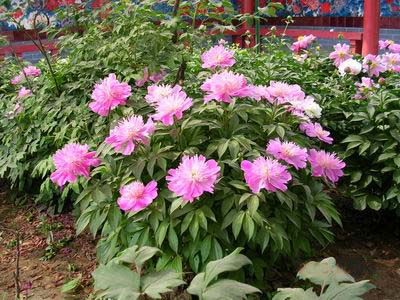
Now, the city is filled with peonies, and each April Luoyang has a festival
for this flower.
This year, the blossom period was one week behind normal because of the cold
weather. Therefore, the peony festival was one week longer than
usual. Luckily, I had a chance to take in the last few-days. I viewed a
sea of treasured peonies.

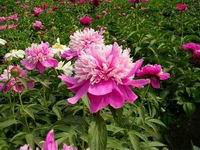
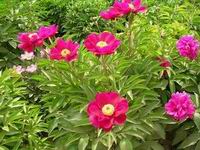
The park I visited is said to be the largest of Luoyang's six major peony
parks. I can't clearly recall its name, however, because the peony parks
in Luoyang have similar and confusing names. Beautiful girls dressed
in Tang gowns guided me throughout the park and showed me the various kinds of
peonies.
Definitely charmed by the peonies, I constantly pressed the shutter of my
camera to take pictures of their lovely blossoms, in red, pink, purple, yellow
and even green!

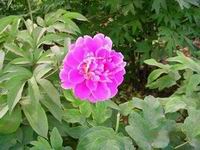
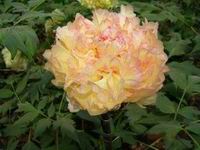
The flowers, mostly as large as palms, were fully and elegantly blossoming
like smiling faces. I could understand why the Chinese have adopted this
flower as a symbol of beauty, royalty, power, happiness and good luck, and why
inkwash painters have tirelessly featured it in their work.
The peonies link my impression of Luoyang as a city of the ancient past to a
modern society. While losing its regal significance from ancient China,
Luoyang is surviving in modern times.
Keeping this in my mind, I stepped onto the train back to Shanghai and
returned into the busy and bustling modern life of this modern
city.



